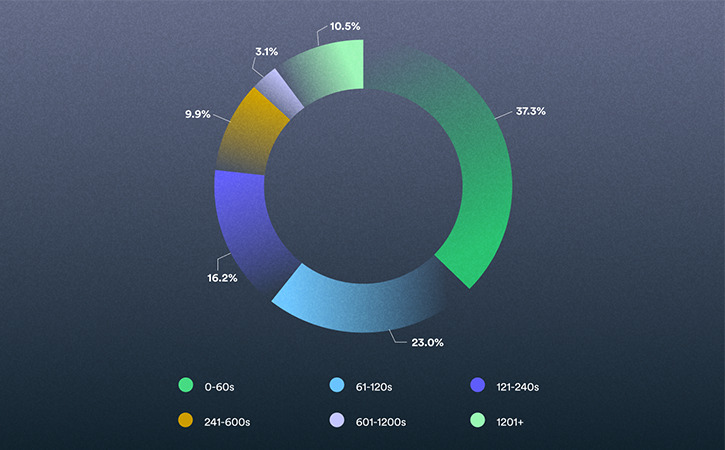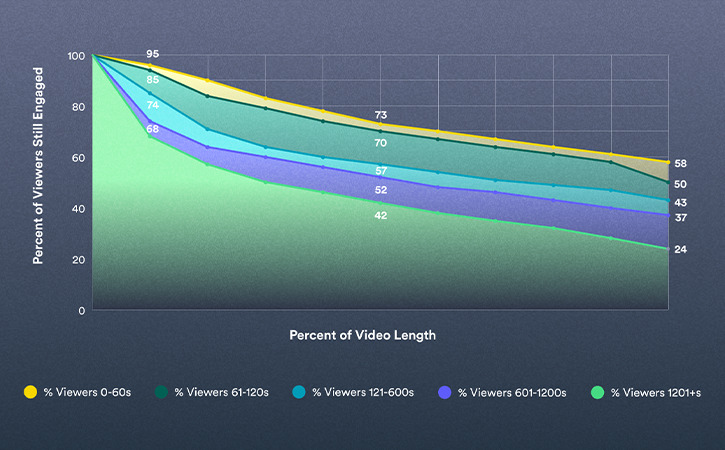The Top Video Marketing and Sales Stats that Matter
[ad_1]
We’ve compiled the top video statistics that matter to businesses with everything from using video for sales calls and virtual conferences to video marketing trends for social media.
We know it can be hard to justify spending resources on a new content type without the data, especially for data-driven businesses. So if you—or your boss—are looking to understand the power of video and want the stats to back it up, then look no further. We’ve compiled the top video marketing statistics that matter to businesses to help you make the best decision for your marketing needs.
Or if you’re a sales leader or rep looking for more intel or insight on how video can grab your prospect’s attention, accelerate deal cycles, and close more business—we’ve got you covered too.
- Contents
- 1. Video for Sales Statistics
- 1.1 Grab Prospects’ Attention
- 1.2 Move Deals Forward to Close
- 1.3 The Transition to Virtual Selling
- 2. Video Marketing Statistics
- 2.1 Video Marketing Strategy
- 2.2 Video Publishing and Production Statistics
- 2.3 Video Length Statistics
- 2.4 Stats Around Video Engagement
- 2.5 Video Analytics Statistics
- 2.6 Online Video Statistics
- 2.7 Mobile Video Statistics
- 2.8 Video Email Statistics
- 2.9 Video SEO Statistics
- 2.10 Video Content Marketing Statistics
- 2.11 Virtual Conference and Webinar Statistics
- 3. Social Media Video Statistics
- 3.1 Facebook Video Statistics
- 3.2 Instagram Video Statistics
- 3.3 LinkedIn Video Statistics
- 3.4 Twitter Video Statistics
- 3.5 Snapchat Video Statistics
- 3.6 YouTube Statistics
- 3.7 TikTok Video Statistics
Video for Sales Statistics
Using video for sales has quickly become a priority for forward-thinking businesses that are looking for the best ways to communicate with their audience and potential customers. The use of one-to-one video (most often used in sales conversations) has exploded in recent years. Looking at the video statistics below, it’s clear that sales reps would be smart to include video in their sales campaigns.
Grab Prospects’ Attention
- 71% of sales pros agree that video email outperforms text-based email. (Vidyard, 2021)
- The use of video in sales and customer conversations was reported by 59% of teams, outranking the distribution of business video on YouTube for the first time ever. (Vidyard, 2022)
- People are 13% more likely to remember details from video emails over text emails. (B2B DecisionLabs, 2021)
- Nearly 90% of sales professionals report the importance of accessing video viewing data to qualify leads, engage prospects, or influence deals. (Vidyard, 2021)
- Video email can reduce inbox fatigue and help recipients retain more of the message when compared to text-based email. (B2B DecisionLabs, 2021)
- Using video for sales outreach has increased response rates for more than 70% of sales reps. (Vidyard, 2021)
- Top-performing sales reps favor cold calls over cold emails, and video is emerging as a top channel. (McKinsey, 2020)
- 58% of viewers watch a business-related video all the way through if it’s less than 60 seconds. (Vidyard, 2021)
- Of the sellers who use custom recorded videos, 70% say that video emails produce more opens, clicks, and responses than text emails. (Vidyard, 2021)
- 46% of people remember details from a text email, but 59% of people remember details from a video within an email. (Vidyard, 2021)
- Hybrid video (a recording of yourself and your screen) garners the highest response rate over selfie-style or traditional screen recording videos. (Vidyard, 2021)
- Many financial services professionals feel like they have gotten to know clients or customers (66%), vendors and partners (50%), and leadership (42%) better by interacting through video more often. (Atomik Research, 2022)
- Globally, 61% of buyers say they can get as much value from meeting suppliers over video conference as they can from in-person visits. (McKinsey, 2022)
“B2B sellers will become experts at creating and engaging with video. As buyer preferences collide with pandemic-related realities, 40% of B2B reps told us in a recent survey that they plan to modify their tactics to adapt to remote selling activities. Traditionally limited to email, phone calls, and screen–sharing interactions, sellers will look for more dynamic ways to earn buyers’ attention.” Forrester blogs– Predictions 2021: Grounded Sellers Fly In The Face Of Old Norms, October 2020
Connect, Convert, and Close More Deals Easily create and share 1-to-1 videos.
Get It Free
Move Deals Forward to Close
- 93% of sellers, marketers and customer experience reps report that video converts the same or better than any other content form. (Vidyard, 2022)
- Close rates have increased for over 50% of sales pros who leverage video as part of their deal cycle. (Vidyard, 2021)
- The top three online video platform functionalities used in video strategies across sales, marketing and customer experience include video performance analytics, in-video calls to action (CTAs), and channel performance analytics. (Vidyard, 2022)
- 76% of sales professionals believe that accessing video viewing data to help qualify leads, engage prospects, and influence deals are important, compared to 67% of marketers. (Vidyard, 2022)
- The average product demo synchronous video call lasts 29 minutes and takes 79% of the meeting. (Zoom/Chorus, 2019)
- Deals that are closed/won used video 18.5% more than deals that are closed/lost. (Zoom/Chorus, 2019)
- Deals that are closed/won used screen sharing (on synchronous video calls) 26.3% more often than deals that are closed/lost. (Zoom/Chorus, 2019)
- The use of video in customer and sales conversations, as well as prospecting, increased by 93% since 2019. (Vidyard, 2021)
- Nearly half of sales pros who leverage video say it has shortened their deal cycle. (Vidyard, 2021)
- Adding a video to your proposal can increase close rates by up to 41%. (Proposify, 2022)
- Video drives 56% higher proposal engagement and helps close your deal 26% faster. (Proposify, 2022)
The Transition to Virtual Selling
- Nearly 80% of sales teams recognize the importance of integrating their video creation and sharing tools with sales engagement technology. (Vidyard, 2022)
- 41% of sales teams plan to invest in user-generated sales videos in 2022. (Vidyard, 2022)
- More than two-thirds of sales teams report they’ll be working in the office part-time or staying remote for the foreseeable future. (Vidyard, 2021)
- 96% of financial services professionals would give up a percentage of their salary to work from home permanently. (Atomik Research, 2022)
- 76% of sales leaders believe that remote sales interactions are equally or more effective than traditional in-person engagement in prospecting for new customers (McKinsey, 2020)
- 64% of those who transitioned to virtual sales this year met or exceeded revenue targets, compared to 50% of the leaders who did not make the transition (HubSpot, 2021)
- Video and CRM tools were the number one and two enablers of success (HubSpot, 2021)
- 63% of sales leaders say virtual meetings are equally or more effective than in-person meetings. (HubSpot, 2021)
- 30% of the underperforming sales organizations now have an FY21 business goal to enable their reps to sell remotely–for the long term (HubSpot, 2021)
- User-generated or user-recorded video (most often used in sales conversations) increased by 129% in 2020 (Vidyard, 2021)
- User-generated video creation increased 44% in the second quarter of the 2020 calendar year—aligning with the initial stages of the COVID-19 pandemic when many sales teams went digital-first (Vidyard, 2021)
- 60% of sales pros define their video recording and editing skills as emerging or proficient. (Vidyard, 2021)
- Only 32% of sales pros report that a virtual sales process requires more meetings to close deals. (Vidyard, 2021)
- 80% of respondents indicate their organization saved money by transitioning to a business model that relies on virtual meetings rather than in-person meetings. (Atomik Research, 2022)
- On average, most financial service professionals prefer to conduct meetings with their customers or clients virtually, using video. (Atomik Research, 2022)
- Only 1% of financial services professionals report that their organization still relies mostly on in-person meetings. (Atomik Research, 2022)
- 89% of financial services professionals say that sending video messages to their clients and prospects would be more impactful than text-based messages. (Atomik Research, 2022)
- 50% of financial services professionals believe incentives tied to the adoption of new business technologies, such as providing employees with decent training on new business technologies, would lead to more widespread adoption of new technologies within their organization. (Atomik Research, 2022)
- 81% of financial service professionals indicate that access to technology for virtual selling is the number one must-have for their work. (Atomik Research, 2022)
- 62% of sellers now interact with customers over digital channels and do not meet face-to-face (ie, mix of telephone, online chat, self-serve portals, email, and video conferencing). (McKinsey, 2022)
- 65% of B2B companies across industry sectors now offer e-commerce capabilities, defined as fully executing a sales transaction online. This is up from 53% in early 2021. (McKinsey, 2022)
- About 61% of B2B sellers offer products/service via video conference over in-person sell
ing, an increase from around 42% pre-COVID. (McKinsey, 2022) - 13% of B2B companies’ revenue is driven by video conferences. (McKinsey, 2022)
Video Marketing Statistics
Marketing teams and content builders around the world have already been embracing the shift to digital channels in this last decade, but the COVID-19 pandemic has really forced businesses to rethink their traditional marketing campaigns to online platforms using video.
Social media, websites, and YouTube are the most popular places to distribute video content. Looking at our roundup of 2021 video marketing statistics, a picture is painted of an industry moving digital and the data to back your business’s case to embrace video marketing too.
Video Marketing Strategy
- The top three video distribution channels for marketers in order are social media, websites, and YouTube. (Vidyard, 2022)
- 92% of marketers who use video say that it’s an important part of their marketing strategy. (HubSpot, 2022)
- According to 88% of marketers, video marketing provides them with positive ROI. When you consider that only 33% said the same in 2015, it shows that consumer sentiment toward videos is much stronger now. (Smart Insights, 2020)
- 86% of businesses use video as a marketing tool. (Wyzowl, 2022)
- A huge proportion of marketers (92%) continue to value video as an ‘important part’ of their marketing strategy. (Wyzowl, 2022)
- 79% of non-video marketers say they expect to start using video as a marketing tool in 2022 (10% more than last year.) (Wyzowl, 2022)
Video Publishing and Production Statistics
- 91% of organizations are maintaining or increasing video content production budgets. (Vidyard, 2021)
- The percentage of companies that create more than 51 videos each year has increased by 261% over the past two years. (Vidyard, 2022)
- Overall business video creation increased by 135% last year. (Vidyard, 2021)
- 60% of all business videos created in 2020 were user-generated or user recorded, while 40% were created or produced in more traditional ways. (Vidyard, 2021)
- Enterprises with over 5,000 employees created on average more than 1,300 videos throughout 2020. (Vidyard, 2021)
- Approximately 75% of video content created by companies under 200 employees is user-generated or user-recorded. (Vidyard, 2021)
- In 2020, the high-tech, financial services, and education and public services industries created more videos on average than in other fields. (Vidyard, 2021)
- Enterprise organizations are evenly split between internal (34%), external (36%), or a combination of both (30%) when it comes to allocating resources for the production of video content. (Vidyard, 2021)
- Small and Medium-sized organizations (both at 57%) rely more heavily on internal resources when it comes to video production. (Vidyard, 2021)
- Companies create a broad range of different videos. 42% mostly use live-action videos, 33% primarily use animated videos and 16% mainly use screen recorded videos. (Wyzowl, 2022)
- On average, most people 40% spend $0-500 on a typical video, with the overwhelming majority 97% spending less than $10,000. (Wyzowl, 2022)
Put Your Videos to Work Create, host, manage, and share your videos.
Sign Up Free
Video Length Statistics
- 59.9% indicated that a video being too long would strongly deter them from watching. (Animoto, 2020)
- Facebook recommends that small businesses try keeping videos to around 15 seconds as much as possible. They shared that 47% of value in a video is delivered in the first 3 seconds. (Animoto, 2020)
- Videos that are an average of 26 seconds receive the most comments on Instagram. (Animoto, 2020)
- The average length of all business-related videos is just over six minutes. (Vidyard, 2021)
- The majority of videos (60%) are less than 2 minutes long. (Vidyard, 2021)
- Only 3% of business videos are 10 to 20 minutes long. (Vidyard, 2021)
- Longer form video content (over 20 minutes in length) grew 66% in 2020. (Vidyard, 2021)
- People watch an average of 19 hours of online video per week (this is an increase of 1 hour per week compared to 12 months ago, and a staggering 8.5 hour increase per week across the past 3 years). (Wyzowl, 2022)
- In 2018, people watched an average of 1.5 hours per day of online video. Our 2022 survey shows this has risen to an average of over 2.5 hours per day. (Wyzowl, 2022)
- The global pandemic has overwhelmingly impacted the amount of time people spend watching videos online. Minutes watched increased 85% in 2020. And, people watched 12.2 billion minutes of video last year; that’s 23,211 years’ worth of content. (HubSpot, 2021)
- The number of videos in the 30–60 minute category grew 140% compared to 2019. This suggests that longer-form content is becoming a more popular option for businesses as more companies embrace video series and other long-form video content. (HubSpot, 2021)
- In 2019, the average global viewer spent six hours and 48 minutes per week watching videos, a 59% increase since 2016. (Sprout Social, 2020)
What is the Average Length of a Business Video?

Source: Vidyard 2021 Video Benchmark Report.
Stats Around Video Engagement
- 88% of people would like to see more video from brands. An increase of 3% from last year. (Wyzowl, 2022)
- People are twice as likely to share video content with their friends than any other type of content. (Wyzowl, 2022)
- The average viewer retention rate for videos across the board is 45%. (Vidyard, 2021)
- 58% of viewers watch a business-related video to the end if it’s under 60 seconds. (Vidyard, 2021)
- Only 24% of viewers finish a video if it’s longer than 20 minutes. (Vidyard, 2021)
- Editing longer-form content like on-demand webinars to under 20 minutes in length can increase viewer retention by 44%. (Vidyard, 2021)
- Video results receive 1.5 engagements per mention (HubSpot, 2022)
- 84% of consumers said watching a brand’s video convinced them to make a purchase or subscribe to a service. (HubSpot, 2022)
What is the Average Engagement for Different Lengths of Video

Source: Vidyard 2021 Video Benchmark Report.
Video Analytics Statistics
- Brands that use advanced video metrics are over 2x more likely to report satisfaction with video, compared to those who don’t use any measures of content effectiveness. (Vidyard, 2022)
- Video performance analytics, such as views and drop-off rates, is voted the most valuable feature of an online video platform. (Vidyard, 2021)
- 73% of companies report they are using some form of video analytics to track video content effectiveness. (Vidyard, 2021)
- Those that use intermediate or advanced analytics typically offered by enterprise video platforms are much more likely to report the return they’re getting from video is improving. (Vidyard, 2021)
- 65% of marketers and nearly 90% of sales professionals report the importance of accessing video viewing data to qualify leads, engage prospects, or influence deals. (Vidyard, 2021)
- The top challenge identified by businesses of all sizes is how to measure video impact. (Vidyard, 2021)
Online Video Statistics
- Millennials watch online videos for 2.4 hours per day while Gen Z averages 3.4 hours. (HubSpot, 2020)
- 51.7% of global internet users aged 16 to 64 say that watching videos, TV shows and movies is their primary reason for using the internet. (Hootsuite, 2021)
- The most common types of business videos are educational in nature and include product demos, how-to’s, explainers, and webinars. (Vidyard, 2021)
- 72% percent of households with wireless internet now stream video on their connected TV screens. (Think With Google, 2020)
- Between 2013 and 2018, video consumption online has increased at an average of 32% per year. (Sprout Social, 2020)
Mobile Video Statistics
- Roughly 71% of Gen Z teens use mobile devices to watch videos, while 51% use mobile for social media surfing. (HubSpot, 2020)
- People are 1.5 times more likely to turn to mobile phones to watch a video. (Facebook, 2020)
- People are 1.5x more likely to watch video daily on a smartphone than on a computer. (Facebook, 2020)
Video Email Statistics
Video SEO Statistics
- Video is the number one form of media used in content strategy, overtaking blogs and infographics. (HubSpot, 2020)
- You have 53x more chances of ranking on the first page of Google if you have videos on your website. (MonsterInsights, 2022)
- Converting blogs into videos can provide you with a new source for driving traffic, as videos can boost your organic traffic by 157%. (MonsterInsights, 2022)
- By 2022, video traffic will amount to 82% of all online consumer traffic, providing SEO experts with an opportunity to gain lots of traffic. (SerpWatch, 2022)
- 78% of businesses say they received more traffic after implementing videos in their content strategies. (SerpWatch, 2022)
- 69% of businesses got more leads with video content, while 54% boosted sales. (SerpWatch, 2022)
- 60% say leads/clicks are the main determining factor of video marketing success. (Wyzowl, 2022)
- 87% of marketers say video has helped them increase traffic. (Wyzowl, 2022)
Video Content Marketing Statistics
- 64% of B2B marketers increased their use of audio or visual content (videos, live streaming, and webinars) in 2019 over their previous commitment. (Content Marketing Institute, 2019)
- The most common types of business videos are educational in nature and include product demos, how-to’s, explainers, and webinars. (Vidyard, 2021)
- When asked how they’d most like to learn about a product or service, 73% said they’d prefer to watch a short video. This compares to 11% who’d rather read a text-based article, website or post, 4% who’d like to view an infographic, 3% who’d rather download an ebook or manual, 3% who’d rather attend a webinar or pitch, and 3% who’d like a sales call or demo (Wyzowl, 2022)
- 70% of businesses say they are creating more videos now compared to the same time last year. (Animoto, 2020)
- Retail and consumer goods companies produced more videos in 2020 over other industries. (Vidyard, 2021)
- Aside from ranking high-budget video features as the least likely reasons for watching videos, millennials and Gen Z differ from older age groups in that they’re more accepting of user-generated content over professionally made videos. (HubSpot, 2020)
- More than 99% of current video marketers will continue using video in 2021, and 96% plan to increase or maintain their spending. (HubSpot, 2021)
- In 2021, there was a 40.5% year-over-year increase in the use of proposal videos. This is up from a 31% YOY increase in 2020. (Proposify, 2022)
- Video remains on top as the #1 form of media used within content strategy in 2021. (HubSpot, 2021)
- Video content is quickly growing in popularity — 46% of buyers prefer video outreach, especially in the absence of face-to-face meetings. (Demandbase, 2021)
Put Your Videos to Work Create, host, manage, and share your videos.
Sign Up Free
Virtual Conference and Webinar Statistics
- Data shows that by June 2020, attendees were spending 28x more time attending virtual events than they had been in January of 2020. In November, that figure jumped to 34x more than in January. In total for 2020, nearly 75 million attendees registered for more than one million virtual events on Eventbrite and logged over 100 million hours. (Eventbrite, 2020)
- 53% of virtual event consumers said they plan to attend both virtual and in-person events in the future—even when it is safe to gather in-person again. (Eventbrite, 2020)
- 25% of people watch webinars from their mobile device. (Work Cast, 2020)
- The sudden shift to virtual events in 2020 produced mixed results in terms of attendance. While just over half of the events lost audience in the transition, 46% gained attendees as a result. Removing travel requirements and audience familiarity with video presentations worked together to keep event attendance largely intact. (Business Wire, 2020)
- 64% of B2B tech buyers expect to spend more on web conferencing software in 2021. (Trust Radius, 2021)
- 50% of attendees at virtual events in 2020 were neutral on their experience, more or less getting what they expected. But nearly a third indicated that they had a better experience than expected. (Business Wire, 2020)
- 56% of webinar hosts said that they used both live and on-demand video. (Letter.ly, 2020)
- According to webinar attendance statistics, most people will only sign up for one live event per week. (Letter.ly, 2021)
- 57% of marketers now use live video within their strategies. (Smart Insights, 2020)
- The most effective video channel statistically was the webinar. Usage held steady at 62% from last year (after a rise from 46% in 2019) but a whopping 90% of marketers who held a webinar said it was an effective tool, making it the most widely praised video marketing channel of all those listed. (Wyzowl, 2022)
- Over a third (34%) of marketers are making use of Facebook’s live streaming options, creating in-the-moment videos that allow viewers to react in real-time. Instagram is the second most popular option, with 13% creating live videos on the platform. (Smart Insights, 2020)
- 91% of webinar marketers say webinars have been a success, making it the most effective video marketing channel. (HubSpot, 2021)
- 93% of businesses landed a new customer because of a video on social media. (Animoto, 2020)
- Half of Gen Z and Millennials “don’t know how they’d get through life without video.” (HubSpot, 2020)
- 91% of marketers are satisfied with the ROI of video marketing on social media. (Animoto, 2020)
- Social media videos make up 68% of the most commonly created types of videos (Wyzowl, 2022)
- There are over half a billion more people using
social media worldwide than at the same time last year, indicating an almost 14% year-over-year increase. (HubSpot, 2022) - 54% of marketers say that video is the most valuable content type for achieving social media marketing goals. (Sprout Social, 2022)
- 93% of companies have acquired new customer(s) via social media videos. (Sprout Social, 2022)
Facebook Video Statistics
- 64% of businesses said that in the last 12 months, a video on Facebook resulted in a new client. (Animoto, 2020)
- 26.4% of the platform’s user base is made up of millennials. That said, over one-third (36%) of Facebook’s audience are 45 or older. (Sprout Social, 2022)
- Facebook video (in-feed) is the most popular type of video content on the platform (51% of users), slightly less than Facebook Live and Watch combined (57%). (Sprout Social, 2022)
- In a 2019 study, 46% of social media users watched videos on Facebook. (Sprout Social, 2020)
- Facebook says that most people will watch other video types to the end if they are 15 seconds long. One study found that if you want higher engagement, 2 to 5 minutes was the range to aim for. (Sprout Social, 2020)
Instagram Video Statistics
- 77% of marketers have posted a video on IGTV. (Animoto, 2020)
- People share 95 million photos and videos on Instagram every day (WordStream, 2022)
- Usage of Instagram grew to 72% from 60% last year, with an effectiveness rating of 85% up from last year’s 82%. (Wyzowl, 2022)
- Over 40 billion photos and videos have been shared on the Instagram platform since its conception. (WordStream, 2022)
- Globally, Instagram video is the most engaging type of content, bringing in an average of 24.25 comments and 1097.9 likes per post. (HubSpot, 2022)
- Over 80% of smartphone users watch video with their phone held vertically, so always design your content with this orientation in mind! (HubSpot, 2022)
- In a 2019 study, 51% of social media users watched videos on Instagram. (Sprout Social, 2020)
- Instagram feed videos are recommended at 26 seconds. (Sprout Social, 2020)
- 91% of users watch videos on Instagram weekly. (Sprout Social, 2022)
LinkedIn Video Statistics
- 68% of video marketers plan to include LinkedIn in their 2022 video marketing strategy (+5% from last year). (Wyzowl, 2022)
- LinkedIn Live streams have increased by 158% since February 2020. (LinkedIn, 2020)
- According to LinkedIn, video content generates 20 times more shares than other types of content on its platform. (Post Beyond, 2020)
- The maximum length for LinkedIn videos is 10 minutes but the network recommends that the ideal length depends on your objective. For brand awareness and consideration, LinkedIn says that a video under 30 seconds has a 200% lift in completion rates. (Sprout Social, 2020)
Twitter Video Statistics
- Twitter recommends videos be 15 seconds or less. (Sprout Social, 2020)
- Tweets with video get 2.5x more replies, 2.8x more Retweets and 1.9x more likes. (Sprout Social, 2022)
- More than 2 billion video views happen every day on Twitter, which is 67% year-over-year growth. (Twitter, 2019)
- Tweets with video attract 10x more engagement than Tweets without video. (Twitter, 2019)
- Promoted Tweets with videos save more than 50% on cost-per-engagement. (Twitter, 2019)
Snapchat Video Statistics
- Snapchat had a big jump in perceived effectiveness increasing from 1% to 13% – a mind-bending increase of 1200%. (Hootsuite, 2022)
- In a 2019 study, 50% of social media users watched videos on Snapchat. (Sprout Social, 2020)
- Snapchat recommends that you keep it within 3 to 5 seconds with the call to action in the first 3 seconds. (Sprout Social, 2020)
YouTube Statistics
- For the eighth consecutive year, YouTube remains the most widely used platform for video marketers – with 86% of video marketers having used it this year. (Wyzowl, 2022)
- Longer Youtube videos at a minimum of 10 minutes have been more popular lately, possibly because that’s the point at which creators are able to insert ads. (Sprout Social, 2020< /a>)
- YouTube surpassed all other networks with 78% of those surveyed having watched a video on the network in the last 24 hours. (Sprout Social, 2020)
- More than 500 hours of video are uploaded to YouTube every minute. (Sprout Social, 2022)
- More than one billion hours of video content are consumed on YouTube daily. (Sprout Social, 2022)
There are 2,291 million global active users on YouTube as of January 2021. (Hootsuite, 2021) - Over 100 million people watch YouTube TV on their TV screens each month in the U.S. (Think with Google, 2020)
- 1 billion total hours of video are watched each day on YouTube. (Hootsuite, 2021)
TikTok Video Statistics
- For the third consecutive year, TikTok adoption increased by 10%, this year reaching 30% (compared to 10% in 2019, and 20% in 2020.) There was also a 10% in the effectiveness rating of TikTok, which reached 77%. (Wyzowl, 2022)
- 33% of video marketers plan to include TikTok in their 2022 video marketing strategy. (+13% from last year). (Wyzowl, 2022)
- A 61% increase in mentions year over year during the first half of 2021, converted into new users, making it the first non-Facebook app to reach 3 billion global downloads. (HubSpot, 2022)
- TikTok’s jump in perceived effectiveness rocketed from 3% last year to 24% this year—a 700% increase. (Hootsuite, 2022)
This post was originally published on December 17, 2020. It was updated on April 13, 2022.
[ad_2]
Source link








